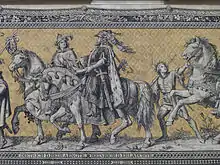Theodoric I, Margrave of Meissen
Theodoric I (11 March 1162 – 18 February 1221), called the Oppressed (Dietrich der Bedrängte), was the Margrave of Meissen from 1198 until his death. He was the second son of Otto II, Margrave of Meissen and Hedwig of Brandenburg.
| Theodoric I | |
|---|---|
| Margrave of Meissen and Lusatia | |
 | |
| Margrave of Meissen | |
| Reign | 1198–1221 |
| Predecessor | Henry VI, Holy Roman Emperor |
| Successor | Henry III |
| Margrave of Lusatia | |
| Reign | 1210–1221 |
| Predecessor | Conrad II |
| Successor | Henry IV |
| Born | 11 March 1162 |
| Died | 18 February 1221 (aged 58) |
| Spouse | Jutta of Thuringia |
| Issue | Hedwig Otto Sophia Konrad (illegitimate) Jutta Henry III, Margrave of Meissen Dietrich II of Meissen (illegitimate) Heinrich (illegitimate) |
| House | House of Wettin |
| Father | Otto II, Margrave of Meissen |
| Mother | Hedwig of Brandenburg |
Biography
Dietrich fell out with his brother, Albrecht the Proud as his mother persuaded his father to change the succession so that Dietrich was given the Margraviate of Meißen and Albrecht (although the older son) the Margraviate of Weißenfels. Albrecht took his father prisoner to try to make him return the succession to the way it had been. After Otto obtained his release by order of the emperor Frederick I, he had only just renewed the war when he died in 1190. Albrecht took back the Meißen margraviate from his brother. Dietrich attempted to regain the margraviate, supported by Landgraf Hermann I of Thuringia, whose daughter he was married to. In 1195, however, he left on a pilgrimage to Palestine.[1]

Albrecht's Death
After Albrecht's death in 1195, leaving no children, Meissen, with its rich mines, was seized by the emperor Henry VI as a vacant fief of the empire. Dietrich finally came into possession of his inheritance two years later on Henry's death.
At the time of the struggle between the two rival kings Philip of Swabia and Otto IV, Holy Roman Emperor, Phillip gave Dietrich the tenure of the march of Meißen again. After that time, Dietrich was on Phillip's side and remained true to the Staufer even after Phillip was murdered in 1208.
Dietrich became caught up in dangerous disagreements with the city of Leipzig and the Meißen nobility. After a fruitless siege of Leipzig, in 1217 he agreed to a settlement but then took over the city by trickery, had the city walls taken down and built three castles of his own within the city, full of his own men.[1]
Death
Margrave Dietrich died on 18 February 1221, possibly poisoned by his doctor, instigated into doing so by the people of Leipzig and the dissatisfied nobility. He left behind a widow, Jutta of Thuringia, daughter of Hermann I, Landgrave of Thuringia. Some of his children had already died.[1]
Marriages and issue
Children from his marriage to Jutta of Thuringia, daughter of Hermann I, Landgrave of Thuringia:[2]
- Hedwig (d. 1249) married Count Dietrich V of Cleves (1185–1260)
- Otto (d. before 1215)
- Sophia (d. 1280) married Count Henry of Henneberg-Schleusingen (d. 1262)
- Jutta married Mestwin II, Duke of Pomerania
- Henry the Illustrious (1218–1288) Margrave of Meissen[3]
Children from extramarital liaisons:
- Konrad
- Dietrich II (not the same as Dietrich von Kittlitz)
- Heinrich
Ancestors
| Ancestors of Theodoric I, Margrave of Meissen | ||||||||||||||||||||||||||||||||||||||||||||||||||||||||||||||||||||||||||||||||||||||||||||||||||||||||||||||||||||||||||||||||||||||||||||||||||||||||||||||||||||||||||||||||||||||||||||||||||||||||||||||||||||||||||||||||||||||||||||||||||||||||||||||||||||||||||||||||||||||||||||||||||||||||||||||||||||||||||||||||||||||||||||||||||||||||||||||||||||||||||||||||||||||||||||||||||||||||||||||||||||||||||||||||||||||||||||||||||||||||||||||||||||||||||||||||||||||||||||||||||||||||||||||||||||||||||||||||||||||||||||||||||||||||||||||||||||||||||||||||||||||||||||||||
|---|---|---|---|---|---|---|---|---|---|---|---|---|---|---|---|---|---|---|---|---|---|---|---|---|---|---|---|---|---|---|---|---|---|---|---|---|---|---|---|---|---|---|---|---|---|---|---|---|---|---|---|---|---|---|---|---|---|---|---|---|---|---|---|---|---|---|---|---|---|---|---|---|---|---|---|---|---|---|---|---|---|---|---|---|---|---|---|---|---|---|---|---|---|---|---|---|---|---|---|---|---|---|---|---|---|---|---|---|---|---|---|---|---|---|---|---|---|---|---|---|---|---|---|---|---|---|---|---|---|---|---|---|---|---|---|---|---|---|---|---|---|---|---|---|---|---|---|---|---|---|---|---|---|---|---|---|---|---|---|---|---|---|---|---|---|---|---|---|---|---|---|---|---|---|---|---|---|---|---|---|---|---|---|---|---|---|---|---|---|---|---|---|---|---|---|---|---|---|---|---|---|---|---|---|---|---|---|---|---|---|---|---|---|---|---|---|---|---|---|---|---|---|---|---|---|---|---|---|---|---|---|---|---|---|---|---|---|---|---|---|---|---|---|---|---|---|---|---|---|---|---|---|---|---|---|---|---|---|---|---|---|---|---|---|---|---|---|---|---|---|---|---|---|---|---|---|---|---|---|---|---|---|---|---|---|---|---|---|---|---|---|---|---|---|---|---|---|---|---|---|---|---|---|---|---|---|---|---|---|---|---|---|---|---|---|---|---|---|---|---|---|---|---|---|---|---|---|---|---|---|---|---|---|---|---|---|---|---|---|---|---|---|---|---|---|---|---|---|---|---|---|---|---|---|---|---|---|---|---|---|---|---|---|---|---|---|---|---|---|---|---|---|---|---|---|---|---|---|---|---|---|---|---|---|---|---|---|---|---|---|---|---|---|---|---|---|---|---|---|---|---|---|---|---|---|---|---|---|---|---|---|---|---|---|---|---|---|---|---|---|---|---|---|---|---|---|---|---|---|---|---|---|---|---|---|---|---|---|---|---|---|---|---|---|---|---|---|---|---|---|---|---|---|---|---|---|---|---|---|---|---|---|---|---|---|---|---|---|---|---|---|---|---|---|---|---|---|---|---|---|---|---|---|---|---|---|---|---|---|---|---|---|---|---|---|---|---|---|---|---|---|---|---|---|---|---|---|---|---|---|---|---|---|---|---|---|---|---|---|---|---|---|---|---|---|---|---|---|---|---|---|---|---|---|---|---|---|---|---|---|---|---|---|---|---|---|---|---|---|---|---|---|---|---|---|---|---|---|---|---|---|---|---|---|---|---|---|---|---|---|---|---|---|---|---|---|
| ||||||||||||||||||||||||||||||||||||||||||||||||||||||||||||||||||||||||||||||||||||||||||||||||||||||||||||||||||||||||||||||||||||||||||||||||||||||||||||||||||||||||||||||||||||||||||||||||||||||||||||||||||||||||||||||||||||||||||||||||||||||||||||||||||||||||||||||||||||||||||||||||||||||||||||||||||||||||||||||||||||||||||||||||||||||||||||||||||||||||||||||||||||||||||||||||||||||||||||||||||||||||||||||||||||||||||||||||||||||||||||||||||||||||||||||||||||||||||||||||||||||||||||||||||||||||||||||||||||||||||||||||||||||||||||||||||||||||||||||||||||||||||||||||
References
- Heinrich Theodor Flathe: Dietrich der Bedrängte. In: Allgemeine Deutsche Biographie (ADB). Volume 5, Duncker & Humblot, Leipzig 1877, p. 186-187 (in German)
- Lyon 2013, p. 243.
- Rasmussen 1997, p. 63.
Sources
- Lyon, Jonathan R. (2013). Princely Brothers and Sisters: The Sibling Bond in German Politics, 1100-1250. Cornell University Press.CS1 maint: ref=harv (link)
- Rasmussen, Ann Marie (1997). Mothers and Daughters in Medieval German Literature. Syracuse University Press.CS1 maint: ref=harv (link)
Theodoric I, Margrave of Meissen Born: 11 March 1162 Died: 18 January 1221 | ||
| Preceded by Emperor Henry VI |
Margrave of Meissen 1198–1221 |
Succeeded by Henry III |
| Preceded by Conrad II |
Margrave of Lusatia 1210–1221 | |